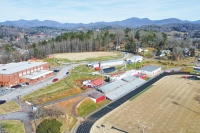Hiking the Pacific Coast Trail with Skywalker
Some The Smoky Mountain News readers may remember a review here several seasons ago of Bill Walker’s Skywalker: Close Encounters on the Appalachian Trail. In that book we met the appropriately named Walker narrating his adventures while hiking the Appalachian Trail. His descriptions of his fellow trailblazers and their various idiosyncrasies made his account a delight for both experienced hikers and general readers.
In Skywalker: Highs and Lows on the Pacific Crest Trail (ISBN 9781453862230), Walker ventures to the other side of the continent tackle the Pacific Crest Trail (PCT), which as he notes in his book “is extraordinary. The diversity of its geology is unequaled by any other footpath in the world.”
Walker goes on to make his case for this bold statement by taking us along with him on his hike and showing us that the PCT, which runs from the Mexican to the Canadian border, runs the gamut from desert to mountains with elevations exceeding 14,000 feet, from the High Sierra, which is frequently blanketed with snow, to the delights of Yosemite National Park, Lake Tahoe, and the ski resorts of Squaw Valley. Because of its twists and turns – the distance covered in a straight line on a map is just over 1,000 miles – the PCT is nonetheless nearly 500 miles longer than the Appalachian Trail, coming in at 2,663.5 miles.
In addition to giving us an account of this terrain and the challenges it presents, Walker recounts his own personal trials. His very height, for example, often worked against him. An extraordinarily tall man – Walker is 6’11” and appears a giant alongside his fellow hikers in the book’s photographs – he points out that the average height of a Boston Marathon winner is just over 5’7”. He then determines that the average hiker of average height would use about 5,000 calories daily, whereas his own caloric demands ran to nearly 7,000 calories daily. On any given five-day trek, then, Walker found that he could carry only about half the food needed to give him the necessary calories. Not only did he lose a great amount of weight during his walk, but he became so emaciated that he feared being unable to finish the trail. In one photograph, he bares his chest and has the look of a man on a starvation strike.
As in his Appalachian account, Walker also gives us many fine thumbnail sketches of his fellow hikers. One of my favorites was his portrait of “Pretty Boy Joe” – all the hikers have nicknames, or are given them by Walker to protect their identity in the book – a 22-year-old graduate of the University of California. “With his long, lean physique,” writes Walker, “straight gaze, and manner of speaking in the soft, unhurried cadences of the West, he even reminded me of a younger Clint Eastwood.” Though the son of a wealthy California realtor, Pretty Boy Joe often dumpster dives for food when off the trail and would have been, Walker contends, a kindred soul with pioneers like Davy Crockett and Daniel Boone.
Though Skywalker: Highs and Lows on the Pacific Crest Trail may seem an odd book to review in a paper devoted to the Smoky Mountains, Walker’s love for his subject and the exuberance of his descriptions make this book a worthy addition to any hiker’s library.
Related Items
•••
Kenneth Slawenski’s J.D. Salinger: A Life (ISBN 978-1-4000-6951-4, $27) attracted a good deal of criticism for its lack of personal detail regarding Salinger’s reclusive years and for what some reviewers called a fawning attitude.
Such negative criticism of Salinger: A Life is unfortunate, for there is gold to be mined in these pages for all those who love the work of the author of Catcher in the Rye, Franny and Zooey, and the other stories published before the author, tormented by publicity and on a spiritual quest, went into hiding. To chide Slawenski for loving Salinger’s books is ridiculous: what sort of biographer would want to write 400 pages about an author whom he disliked?
Slawenski carefully works his way through Salinger’s stories, and fans will take delight in his insights and his careful critiques. In addition, he goes to great lengths to examine Salinger’s spiritual development over the years, his increasing association of the spiritual with the act of writing, and his obsessive need for the private life (Salinger’s own daughter was unaware of her father’s occupation until she went to school, where an amused teacher told her that her father was a famous author).
Nor will readers be disappointed by Slawenski’s personal history of Salinger. He has done great service here showing us the depth of the effect of World War II on the young writer, and gives us blow-by-blow accounts of Salinger’s battles with the public, publishers, and copy-cat authors. Doubtless he does leave out some of Salinger’s mean-spirited behavior toward his wives and children, but a good bit of this side of the story is gossip and another good bit has already found documentation elsewhere. Given the penchant in our society for finding “dirt” on our celebrities, it is a relief in many ways to read the biography of an author in which the biographer seems as interested in his subject’s work as in a body count of the women bedded or the friends and lovers mistreated.









